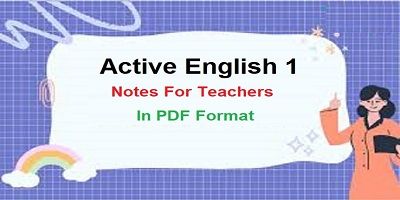Active English – 1
“Active English 1” typically refers to an educational curriculum or textbook series designed for teaching English language skills to young learners, often at the primary or elementary school level. In this context, the term “active” suggests a focus on engaging, participatory learning methods rather than passive instruction.
Here are some common features and characteristics of “Active English 1”:
- Target Audience: It is designed for young learners, usually in the early stages of English language acquisition, such as primary school students.
- Curriculum Content: The curriculum covers foundational aspects of English language learning, including reading, writing, speaking, and listening skills. It may include basic grammar, vocabulary building, and comprehension exercises.
- Interactive Learning: Emphasis is placed on active learning methodologies, such as group activities, role-playing, games, and hands-on exercises, to encourage student engagement and participation.
- Integration of Skills: Lessons are often designed to integrate various language skills seamlessly, helping students develop holistic language proficiency.
- Teacher Support: The curriculum typically provides teachers with resources such as lesson plans, teaching guides, supplementary materials, and assessment tools to facilitate effective instruction.
- Assessment: It includes methods for assessing student progress and understanding, usually through formative assessments (ongoing checks for understanding) and summative assessments (end-of-unit or end-of-term evaluations).
- Pedagogical Approach: The approach may align with contemporary educational theories emphasizing learner-centered instruction, differentiation, and the use of diverse teaching strategies to cater to different learning styles.
Overview of Active English – 1
- Introduction to the curriculum and its objectives
- Target audience (grade level, student demographics)
- Importance of active learning in English education
Curriculum Framework
- Breakdown of units and topics covered
- Learning outcomes and goals for students
- Integration of language skills (reading, writing, speaking, listening)
Teaching Strategies
- Effective methods for engaging students in active learning
- Differentiated instruction approaches
- Incorporation of technology and multimedia resources
Lesson Planning
- Steps for effective lesson planning using Active English – 1
- Alignment with educational standards
- Assessment strategies and tools
Supporting Materials
- Recommended textbooks and supplementary resources
- Worksheets, activities, and projects to enhance learning
- Strategies for adapting materials for diverse learners
Professional Development
- Opportunities for teacher training and workshops
- Continuous improvement in teaching practices
- Collaboration with peers and sharing best practices
Assessment and Evaluation
- Methods for assessing student progress
- Formative and summative assessment strategies
- Rubrics and criteria for evaluating language proficiency
Parental and Community Involvement
- Importance of parental support in language learning
- Strategies for fostering community engagement
- Communication channels and feedback mechanisms
Conclusion
“Active English 1” aims to lay a solid foundation for further English language development, preparing students for more advanced language skills in subsequent grades or levels. Specific details and content may vary depending on the educational standards and curriculum framework schools or institutions adopt.
Appendix
- Sample lesson plans
- Glossary of terms
- References and further reading
